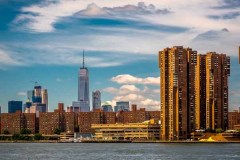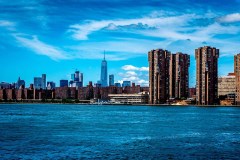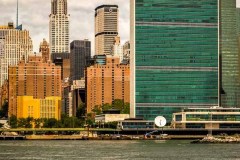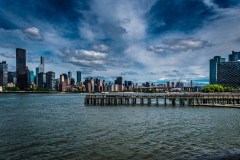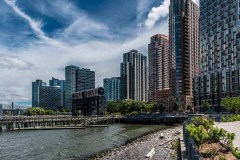Long Island City history
Long Island City is a neighborhood in the westernmost part of the borough of Queens in New York City. Originally known as Hunter’s Point, the area was primarily rural until the mid-19th century, when industrialization began to take hold.
In the 1850s, the area saw the construction of the Long Island Rail Road, which made transportation to Manhattan much easier. This led to a boom in manufacturing and industrialization, with factories and warehouses sprouting up along the East River waterfront. The area became known as Long Island City in 1870, and it was officially incorporated as a city in 1871.
Long Island City continued to grow throughout the late 19th and early 20th centuries, with new industries moving in and a large number of immigrants settling in the area. In the early 20th century, the area also became a center for film production, with many studios and production companies based in the neighborhood.
During the mid-20th century, Long Island City faced economic decline, as many of the factories and warehouses closed down and the population dwindled. However, in recent decades, the area has undergone a significant transformation, with new residential and commercial development, as well as the establishment of cultural institutions like the Museum of the Moving Image and the Noguchi Museum. Today, Long Island City is a thriving neighborhood, known for its mix of old and new architecture, artistic community, and proximity to Manhattan.
Long Island City then and now
Long Island City has undergone significant changes over the years, evolving from a primarily industrial area to a thriving residential and commercial neighborhood. Here are some of the key differences between Long Island City then and now:
- Industrialization: Long Island City was once a hub of manufacturing and industry, with factories and warehouses dominating the landscape. Today, many of these industrial spaces have been converted into residential buildings, offices, and retail spaces.
- Transportation: The Long Island Railroad was instrumental in the development of Long Island City, and it remains an important transportation hub today. In addition, the neighborhood is now served by multiple subway lines, making it easy to commute to and from Manhattan.
- Population: Long Island City has seen a significant increase in population over the years, with many young professionals and families moving to the area in search of affordable housing and easy access to Manhattan.
- Cultural institutions: Long Island City is now home to several important cultural institutions, including the Museum of the Moving Image, the Noguchi Museum, and the Socrates Sculpture Park.
- Development: Long Island City has undergone a major transformation in recent years, with new residential and commercial development springing up all over the neighborhood. This has brought new restaurants, bars, and shops to the area, as well as a more vibrant and diverse community.
The neighborhood of Long Island City
Now, Long Island City neighborhood change from street to street. Now, it is full of a large, new and very large and small parks and playground for all ages, nice restaurant. The best and the most attractive in Long Island city is the view to Manhattan. All of this attraction are busy at all the time if you plan to go there especially when the weather is good.
Long Island City is a diverse and vibrant neighborhood located in the westernmost part of the borough of Queens in New York City. The neighborhood is bordered by the East River to the west, Astoria to the north, Sunnyside to the east, and the Queensboro Bridge to the south.
Long Island City is known for its mix of old and new architecture, with many historic buildings and industrial spaces coexisting alongside newer residential and commercial developments. The neighborhood is home to a diverse mix of people, including young professionals, families, artists, and immigrants from all over the world.
One of the most notable features of Long Island City is its thriving arts and culture scene. The neighborhood is home to several important cultural institutions, including the Museum of the Moving Image, the Noguchi Museum, and the Socrates Sculpture Park. In addition, Long Island City is home to many galleries, studios, and performance spaces, making it a hub for the arts in New York City.
Long Island City is also known for its many parks and outdoor spaces, including Gantry Plaza State Park, which offers stunning views of the Manhattan skyline, and Hunters Point South Park, which features a waterfront promenade, playgrounds, and sports fields.
The neighborhood is also home to a diverse range of restaurants, cafes, bars, and shops, with something to suit every taste and budget. Overall, Long Island City is a dynamic and rapidly evolving neighborhood, with much to offer residents and visitors alike.
The Commute to Long Island City
Long Island City is located in the westernmost part of Queens, just across the East River from Manhattan. As such, it is well-connected to the rest of the city and beyond by a variety of transportation options.
- Subway: Long Island City is served by several subway lines, including the 7, E, M, N, R, and W trains. The 7 train is particularly convenient for getting to and from Manhattan, as it stops at several key locations in Midtown.
- Long Island RailRoad: The Long Island Rail Road also serves Long Island City, with several stops in the neighborhood. The LIRR provides quick and easy access to other parts of Queens and Long Island, as well as to Penn Station in Manhattan.
- Bus: Several bus lines run through Long Island City, providing connections to other parts of Queens and beyond.
- Ferry: NYC Ferry provides service to Long Island City, with stops at Hunters Point South and Gantry Plaza State Park. The ferry is a scenic and convenient way to travel to and from Manhattan and other parts of the city.
- Bike: Long Island City is also bike-friendly, with several bike lanes and bike share stations located throughout the neighborhood. Cycling can be a great way to commute to and from work, especially during the warmer months.
Overall, Long Island City is easily accessible by a variety of transportation options, making it a convenient and accessible neighborhood for commuters.
.
https://www.timeout.com/newyork/queens/long-island-city-queens-neighborhood-guide
https://www.niche.com/places-to-live/n/long-island-city-new-york-city-ny/
https://www.distancecalculator.net/from-new-york-city-to-long-island-city
https://www.hotels.com/de1527530/hotels-long-island-city-new-york/


